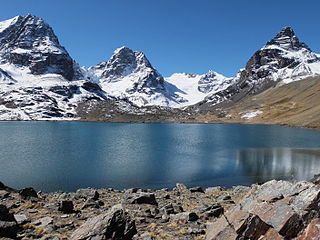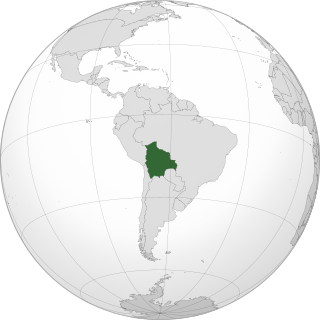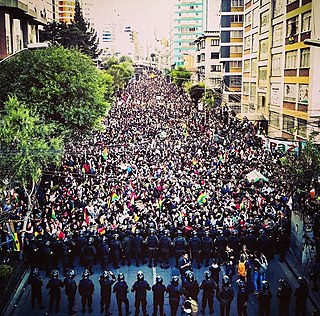Related Research Articles

Bolivia, officially the Plurinational State of Bolivia, is a landlocked country located in western-central South America. The capital is Sucre, while the seat of government and financial center is located in La Paz. The largest city and principal industrial center is Santa Cruz de la Sierra, located on the Llanos Orientales, a mostly flat region in the east of the country.

La Paz, officially known as Nuestra Señora de La Paz, also named Chuqi Yapu (Chuquiago) in Aymara, is the seat of government and the de facto national capital of the Plurinational State of Bolivia. With an estimated 789,541 residents as of 2015, La Paz is the third-most populous city in Bolivia. Its metropolitan area, which is formed by La Paz, El Alto and Viacha, makes up the most populous urban area in Bolivia, with a population of 2.3 million. It is also the capital of the La Paz Department.

Bolivia traditionally has maintained normal diplomatic relations with all hemispheric states except Chile. Foreign relations are handled by the Ministry of Foreign Affairs, headed by the Chancellor of Bolivia, Fernando Huanacuni Mamani, the successor of David Choquehuanca Céspedes.

The La Paz Department of Bolivia comprises 133,985 square kilometres (51,732 sq mi) with a 2012 census population of 2,706,359 inhabitants. It is situated at the western border of Bolivia, sharing Lake Titicaca with adjacent Peru. It contains the Cordillera Real, which reaches altitudes of 6.6 kilometers (4.1 mi). Northeast of the Cordillera Real are the Yungas, the steep eastern slopes of the Andes Mountains that make the transition to the Amazon River basin to the northeast. The capital of the department is the city of La Paz and is the administrative city and seat of government/national capital of Bolivia.

Illimani (Aymara) is the highest mountain in the Cordillera Real of western Bolivia. It lies near the cities of El Alto and La Paz at the eastern edge of the Altiplano. It is the second highest peak in Bolivia, after Nevado Sajama, and the eighteenth highest peak in South America. The snow line lies at about 4,570 metres (15,000 ft) above sea level, and glaciers are found on the northern face at 4,983 m (16,350 ft). The mountain has four main peaks; the highest is the south summit, Nevado Illimani, which is a popular ascent for mountain climbers.

The Movement for Socialism–Political Instrument for the Sovereignty of the Peoples, alternately referred to as the Movement Toward Socialism or the Movement to Socialism, is a Bolivian left-wing populist and indigenist political party led by Evo Morales, founded in 1998. Its followers are known as Masistas.

Estadio Hernando Siles is a sports stadium in La Paz, Bolivia. It is the country's largest sports complex with a capacity of 41,143 seats. It is named after Hernando Siles Reyes, the 31st President of Bolivia (1926–1930). The stadium is located in the Miraflores borough of La Paz, at an altitude of 3,637 metres above sea level, making it one of the highest professional stadiums in the world. The Stadium was opened in 1931 with a match between The Strongest and its classic rival, Universitario, with The Strongest winning 4–1. It is the home ground of three major Bolivian league football clubs, Club Bolivar, The Strongest and La Paz F.C. as well as several smaller top sides: Universitario de La Paz, Chaco Petrolero and Mariscal Braun. The stadium also hosts lower league clubs: Fraternidad Tigres and Academia de Balompié Boliviano.

El Alto is the second-largest city in Bolivia, located adjacent to La Paz in Pedro Domingo Murillo Province on the Altiplano highlands. El Alto is today one of Bolivia's fastest-growing urban centers, with a population of 974,754 in 2011. El Alto is the highest major metropolis in the world, with an average elevation of 4,150 m (13,615 ft).

Christianity is the largest religion in Bolivia, with Roman Catholicism being the largest denomination.

The current Constitution of Bolivia came into effect on February 7, 2009 when it was promulgated by President Evo Morales, after being approved in a referendum with 90.24% participation. The referendum was held on January 25, 2009, and the constitution was approved by 61.43% of voters.

Juan Bastos is an Venezuela-American portrait artist of Bolivian descent who also creates other representational art, including pieces that utilize mythology and symbolism. He works primarily in painting and drawing and currently resides in Los Angeles, California.

Xavier Moyano is an Argentine musician; producer, performer, composer, and educator. He began his career as a session guitarist in Tucuman in 1999. By 2003 was the guitarist for rock/pop band AVe Cesar until 2008, after that he became a solo rock instrumentalist. He is currently a session musician, guitarist and producer of Cossas Novas, Los Delirantes and RockBro's (Rock).

The history of the Jews in Bolivia stretches from the colonial period of Bolivia in the 16th century to the end of the 19th century. In the 19th century, Jewish merchants came to Bolivia, most of them taking local women as wives and founding families that merged into the mainstream Catholic society. This was often the case in the eastern regions of Santa Cruz, Tarija, Beni and Pando, where these merchants came either from Brazil or Argentina.

Bolivia–Mexico relations refers to the diplomatic relations between the Plurinational State of Bolivia and the United Mexican States. Both nations are members of the Community of Latin American and Caribbean States, Latin American Integration Association, Organization of American States, Organization of Ibero-American States and the United Nations. There is a community of approximately 10,000 Mexican citizens residing in Bolivia.

Mi Teleférico, also known as Teleférico La Paz–El Alto, is an aerial cable car urban transit system serving the La Paz–El Alto metropolitan area in Bolivia. As of September 2018, the system consists of 25 stations along eight lines: Red, Yellow, Green, Blue, Orange, White, Sky Blue, and Purple. Another three lines are in planning or construction: Brown, Silver, and Gold.
Eliana Paco Paredes is an indigenous Aymara Bolivian fashion designer from La Paz. In 2016, after exhibiting her chola designs at the Bolivia Fashion Week in June, she achieved recognition in New York City, participating in the September fashion week.

The Casa Grande del Pueblo, is the Bolivian presidential residence (palace) that replaced the Palacio Quemado.
Cristina Corrales Real was a Bolivian journalist, radio broadcaster, and politician.

Since 21 October 2019, protests and marches have been occurring in Bolivia in response to claims of electoral fraud in the 2019 general election of 20 October 2019 and, subsequently, to Jeanine Áñez declaring herself the acting president of Bolivia. The claims of fraud were made after the suspension of the preliminary vote count, in which incumbent Evo Morales was not leading by a large enough margin (10%) to avoid a runoff, and the subsequent publication of the official count, in which Morales won by over 10%. Some international observers have expressed concern over these developments. After conducting a statistical analysis of the election resutls, resarchers at MIT disputed the claims of electoral fraud, stating, "There is not any statistical evidence of fraud that we can find — the trends in the preliminary count, the lack of any big jump in support for Morales after the halt, and the size of Morales’s margin all appear legitimate."
References
- 1 2 "Bolivia, desde una mirada fresca - Diario Pagina Siete" (in Spanish). Retrieved 19 November 2018.
- ↑ Harry Stewart. "The Most Non-Touristy Experiences in La Paz, Bolivia". Culture Trip. Retrieved 12 November 2018.
- ↑ Erika Ibargüen (2 June 2015). "Bolivian Express lanza su edición número 50". La Razon. Retrieved 12 November 2018.